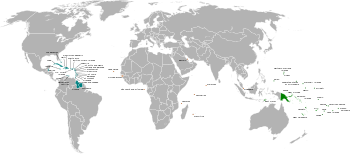Small Island Developing States
These include small but growing populations, limited resources, remoteness, susceptibility to natural disasters, vulnerability to external shocks, excessive dependence on international trade, and fragile environments.
Many citizens of SIDS live near a coastline, meaning that they have a high risk exposure to the effects of marine climate change.
[7] In addition to these vulnerabilities, the energy sector in SIDS faces unique challenges and opportunities, particularly in the least-electrified regions.
Technologies such as biomass gasification, small-scale hydro, and solar PV not only offer paths to reduce their carbon footprint but also enhance resilience against climate impacts.
The report highlights case studies from Guinea-Bissau, Papua New Guinea, and Vanuatu, showing significant socio-economic benefits from improved energy access, including increased income opportunities for rural women and reduced indoor air pollution.

